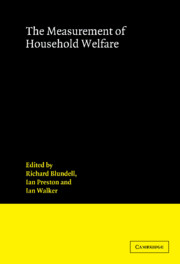Book contents
- Frontmatter
- Contents
- List of contributors
- 1 An introduction to applied welfare analysis
- 2 Measuring the cost of children: a theoretical framework
- 3 The collective approach to household behaviour
- 4 Ordinal and cardinal utility: an integration of the two dimensions of the welfare concept
- 5 The determination of welfare in nonintact families
- 6 Female labour supply, housework and family welfare
- 7 Engel equivalence scales in Sri Lanka: exactness, specification, measurement error
- 8 Measuring the life-cycle consumption costs of children
- 9 Family fortunes in the 1970s and 1980s
- 10 Ethically-consistent welfare prescriptions are reference price-independent
- 11 The effect of systematic misperception of income on the subjective poverty line
- Index of names
- Index of subjects
4 - Ordinal and cardinal utility: an integration of the two dimensions of the welfare concept
Published online by Cambridge University Press: 13 January 2010
- Frontmatter
- Contents
- List of contributors
- 1 An introduction to applied welfare analysis
- 2 Measuring the cost of children: a theoretical framework
- 3 The collective approach to household behaviour
- 4 Ordinal and cardinal utility: an integration of the two dimensions of the welfare concept
- 5 The determination of welfare in nonintact families
- 6 Female labour supply, housework and family welfare
- 7 Engel equivalence scales in Sri Lanka: exactness, specification, measurement error
- 8 Measuring the life-cycle consumption costs of children
- 9 Family fortunes in the 1970s and 1980s
- 10 Ethically-consistent welfare prescriptions are reference price-independent
- 11 The effect of systematic misperception of income on the subjective poverty line
- Index of names
- Index of subjects
Summary
Introduction
One of the key concepts in economics is utility or welfare. The first thorough introductions of the concept were those by Gossen (1854), Jevons (1871) and Edgeworth (1881). They assumed that a commodity bundle x in the commodity space (R+n) contained an intrinsic utility value U(x). The consumer problem could then be described as looking for the bundle with the highest utility value that could be bought at prices p and income y.
Such a model was able to describe and to predict purchase behaviour. This was the behavioural aspect. But the model was also to be used for normative purposes, where we compare utility differences between bundles x1, x2, x3 for a specific individual. This is called intra-personal comparison. The utility of income levels y1, y2, y3 may be calculated by means of the indirect utility function V(y,p) which is defined as the maximum utility to be derived from income y at given prices p.
This led to the progressive income taxation rules, suggested by Cohen Stuart (1889) among others. Actually the latter use implies also that utility differences are comparable between individuals. This is called inter-personal comparability.
It would then also be possible to define social welfare functions W(U1,…, Un) where social welfare is a function of individual utilities. The most obvious application of that concept is to compare distributions of social wealth and to devise policies which will lead to a better distribution.
- Type
- Chapter
- Information
- The Measurement of Household Welfare , pp. 86 - 110Publisher: Cambridge University PressPrint publication year: 1994
- 6
- Cited by



